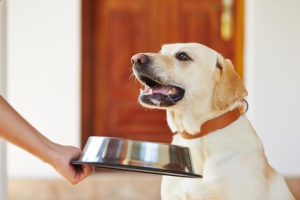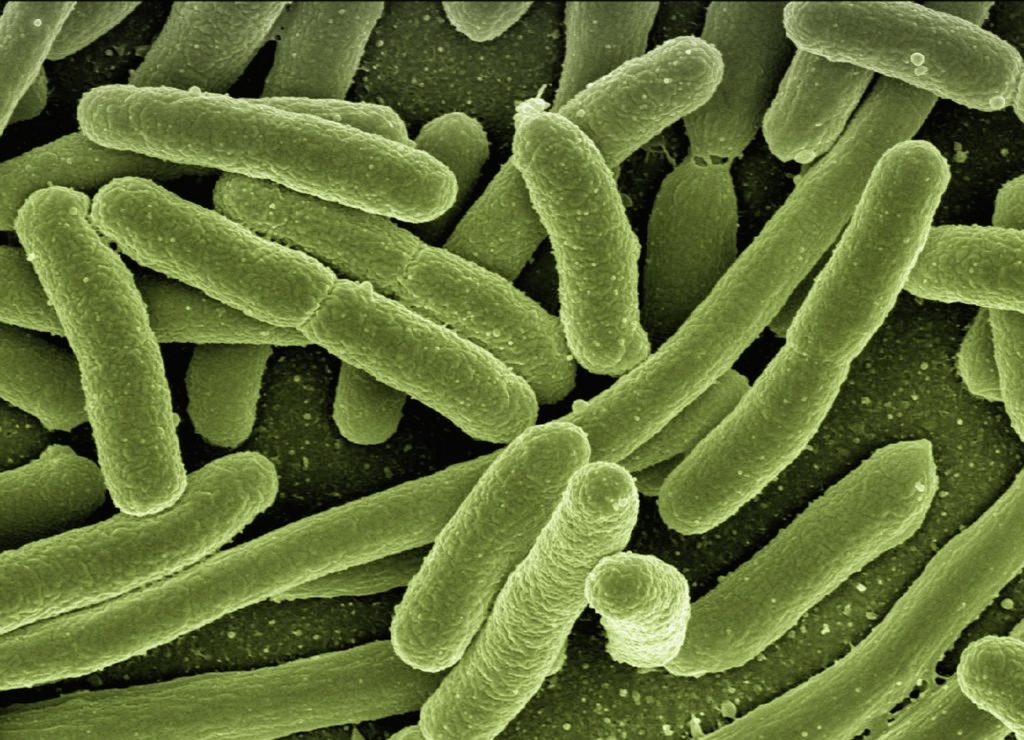
Have you ever in your life eaten dinner on a plate, left the plate sitting on the counter over night without so much as a rinse and then used that same plate for breakfast the next morning? Of course you haven’t! The very thought of it is enough to send your tummy turning.
Despite that, so many of us feed our pup in the same dish over and over without cleaning it. Or, maybe we are really on top of that and our dog’s dish is sparkling clean because we clean it everyday with our own dishes. Can you use the same sponge on your dishes and his? Let’s get down and dirty about keeping the dog bowls clean.

Bark! What Grows There?
Turns out there are some good reasons to follow basic guidelines for keeping your dog’s dishes and eating area clean and sanitized, both for your dog’s health and that of your family. Namely, a slew of very scary sounding bacteria that love to grow in your dog’s mouth and on her dishes.
William (Bill) Burkholder, DVM, PhD, DACVN, and Charlotte Conway, MS, from the Center for Veterinary Medicine at the Food and Drug Administration say that the kinds and quantities of bacteria on your dog’s dish depend on the kind of food you feed and the oral hygiene of your dog. As your dog eats, germs from the mouth transfer to the bowl and vice versa. Also, diets that include raw meat or moist food breed more bacteria than dry kibble.

Burkholder and Conway said, “What kind of bacteria grow in the bowls depends on factors like the environment, exposure and oral hygiene of the animal, but possible examples include Staphylococcus aureus, Pasteurella multocida and different species of Corynebacterium, Streptococcus, Enterobacteria, Neisseria, Moraxella, Bacillus and, less frequently, Salmonella and Pseudomonas.”
In other words, germs and lots of them. Germs that can be especially harmful to babies of the human and canine kind and adults who are immunocompromised.
Keeping it Clean
Now that we know beyond a shadow of doubt that regular cleaning is definitely called for, how often should we do it? If you feed your pup dry kibble, it is ideal to clean the dish once a day. If you feed raw meat or wet food, the dish should really be cleaned after each meal.
Water dishes shouldn’t be overlooked either but it seems we might be doing just that. A 2011 study by the NSF looked at what items in typical households were the germiest. Coming in 4th place was the oft neglected dog water dish. These need to be cleaned daily in an ideal world. If you’re like most of us, that’s just unrealistic so do your fur baby a favor and wash that water bowl with regularity.

Your pup’s food and water dishes should be placed on a feeding mat rather than directly on the floor. Dogs love to give their bowl and sometimes the entire area around it a good long lick fest after a feeding. This is especially true if some food falls out of the bowl. Keeping the dishes on a mat ensures she won’t lick the floor directly and take in harmful chemicals found in many floor cleaning products.
If your dog has a plastic or wooden dish, beware of scratches or cracks in the bowl. These crevices are perfect breeding grounds for germs in high numbers. If the dish gets scratched or cracked, it’s time to replace it.
Another great tip is to have a few bowls available at any given time. That way you’ve always got a fresh and clean dish on hand when it comes to feeding time.
To Sponge or Not to Sponge?
Sponges are always a hot topic in any discussion of germs. A 2017 study on kitchen sponges sent the media and home chefs into a frenzy when the researched likened a kitchen sponge to a toilet in terms of bacteria density. Blech! Replacing your kitchen sponge every one to two weeks and running it through the dishwasher or microwave every couple of days appears to be the remedy of choice for keeping the colony under control.
That’s all fine and well but should you use the kitchen sponge to clean your dog’s dish? In short, no. If sponges are your cleaning tool of choice, you should use a designated one for your pup’s dish. That will keep cross contamination down and so long as you using regularly sanitized and replaced sponges you can ignore the whole comparison to a toilet thing.
Dishwasher for the Win
The dishwasher is your best bet for keeping your dog’s dishes both clean and sanitized. The scalding hot water that pumps through that puppy kills all the germs that may be taking up residence there. You simply cannot get your hand washing water hot enough to come close to the sanitizing powers of your dishwasher.
Even plastic dishes should be dishwasher safe, provided you put them on the top rack. Just make a habit to leave a space for the dog bowls and run them through every time you run the dishwasher. Your family, home, and beloved pup will be better off for it.
How often do you wash your dog’s bowls? What’s your cleaning method of choice? Does the water dish get as much attention as the food dish?
The post Protect Your Dog And Yourself From This Potentially Deadly Invisible Danger Lurking In Your Home appeared first on iHeartDogs.com.
via Whisker Therapy